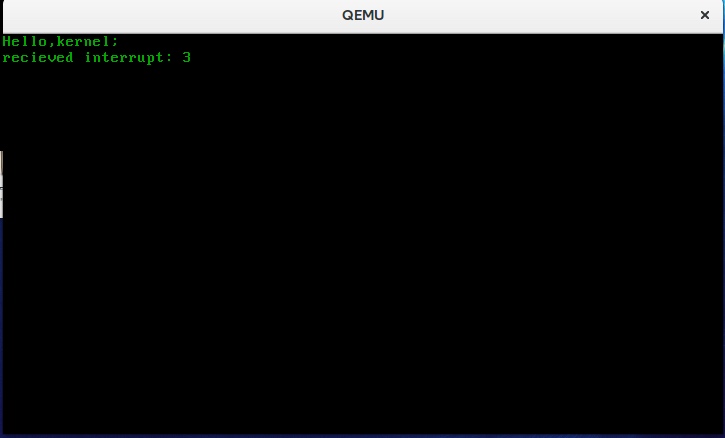1
2
3
4
5
6
7
8
9
10
11
12
13
14
15
16
17
18
19
20
21
22
23
24
25
26
27
28
29
30
31
32
33
34
35
36
37
38
39
40
41
42
43
44
45
46
47
48
49
50
51
52
53
54
55
56
57
58
59
60
61
62
63
64
65
|
#include "idt.h"
#include "string.h"
extern void idt_flush(u32);
struct idt_descriptor idt[256];
struct idtr_struct idtr;
void idt_set_descriptor(int num,u32 offset,u16 seg,u8 flags);
void init_idt(){
idtr.limit = sizeof(struct idt_descriptor) * 256 - 1;
idtr.base = (u32)&idt;
bzero(&idt,sizeof(struct idt_descriptor) *256);
idt_set_descriptor( 0, (u32)isr0, 0x08, 0x8E);
idt_set_descriptor( 1, (u32)isr1, 0x08, 0x8E);
idt_set_descriptor( 2, (u32)isr2, 0x08, 0x8E);
idt_set_descriptor( 3, (u32)isr3, 0x08, 0x8E);
idt_set_descriptor( 4, (u32)isr4, 0x08, 0x8E);
idt_set_descriptor( 5, (u32)isr5, 0x08, 0x8E);
idt_set_descriptor( 6, (u32)isr6, 0x08, 0x8E);
idt_set_descriptor( 7, (u32)isr7, 0x08, 0x8E);
idt_set_descriptor( 8, (u32)isr8, 0x08, 0x8E);
idt_set_descriptor( 9, (u32)isr9, 0x08, 0x8E);
idt_set_descriptor(10, (u32)isr10, 0x08, 0x8E);
idt_set_descriptor(11, (u32)isr11, 0x08, 0x8E);
idt_set_descriptor(12, (u32)isr12, 0x08, 0x8E);
idt_set_descriptor(13, (u32)isr13, 0x08, 0x8E);
idt_set_descriptor(14, (u32)isr14, 0x08, 0x8E);
idt_set_descriptor(15, (u32)isr15, 0x08, 0x8E);
idt_set_descriptor(16, (u32)isr16, 0x08, 0x8E);
idt_set_descriptor(17, (u32)isr17, 0x08, 0x8E);
idt_set_descriptor(18, (u32)isr18, 0x08, 0x8E);
idt_set_descriptor(19, (u32)isr19, 0x08, 0x8E);
idt_set_descriptor(20, (u32)isr20, 0x08, 0x8E);
idt_set_descriptor(21, (u32)isr21, 0x08, 0x8E);
idt_set_descriptor(22, (u32)isr22, 0x08, 0x8E);
idt_set_descriptor(23, (u32)isr23, 0x08, 0x8E);
idt_set_descriptor(24, (u32)isr24, 0x08, 0x8E);
idt_set_descriptor(25, (u32)isr25, 0x08, 0x8E);
idt_set_descriptor(26, (u32)isr26, 0x08, 0x8E);
idt_set_descriptor(27, (u32)isr27, 0x08, 0x8E);
idt_set_descriptor(28, (u32)isr28, 0x08, 0x8E);
idt_set_descriptor(29, (u32)isr29, 0x08, 0x8E);
idt_set_descriptor(30, (u32)isr30, 0x08, 0x8E);
idt_set_descriptor(31, (u32)isr31, 0x08, 0x8E);
idt_flush((u32)&idtr);
}
void idt_set_descriptor(int num,u32 offset,u16 seg,u8 flags){
idt[num].offset_low = offset & 0xFFFF;
idt[num].offset_high = (offset >> 16 ) &0xFFFF;
idt[num].seg = seg;
idt[num].zero = 0;
idt[num].flags = flags;
}
|

